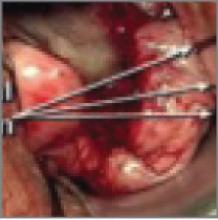The more numerous the choices of surgical techniques for pelvic organ prolapse, the less agreement there is on which operation is best. Further complicating the picture is the industry’s push to consider augmentation with synthetic or biologic materials on an almost routine basis.
Few scientific comparisons of the various approaches have been performed, however. To help shed some light on surgical decision-making, we convened an expert panel to review published data and explore our experience with selected procedures.
What to consider before choosing a procedure
- A woman’s desires regarding sexual activity are a critical piece of information, just as are her general health and history of pelvic surgery.
- It also helps to know which symptoms of her prolapse and related pelvic floor disorders she finds most bothersome.
KARRAM: When a woman with symptomatic pelvic organ prolapse desires surgical correction, what factors do you explore before deciding which procedure to use?
BRUBAKER: I make an effort to determine the woman’s readiness to undergo surgery and her expectations for it, as well as any concomitant pelvic floor or medical/surgical conditions.
Other important factors that I consider include her pelvic surgical history—specifically, whether she has undergone earlier continence and/or prolapse repairs—and the presence of any materials in the proposed surgical site, especially foreign bodies that may limit dissection planes or have eroded into pelvic viscera.
I also consider her desire (or lack of it) for sexual activity, and her preferred route of surgical access.
Patient’s lifestyle should sway surgical decision
PARAISO: I take into account her age and stage of prolapse; vaginal length; innervation of the pelvic floor; hormonal status; desire for uterine preservation and coitus; symptoms of sexual, urinary, or bowel dysfunction; and any comorbidities that influence her eligibility for anesthesia or chronically increase intra-abdominal pressure. Connective tissue disorders are also important, as are any coexisting medical conditions that impede healing.
Lifestyle has an impact, too, especially if she regularly performs heavy manual labor.
After assessing the patient’s history and performing an examination, I target the prolapse and functional symptoms and correlating anatomic defects that exacerbate her quality of life. I tailor her surgical therapy in order to correct her symptoms and minimize compensatory defects and de novo dysfunction.
Ask her to prioritize her complaints
SHULL: I have the patient list her complaints in order of their severity and impact on her lifestyle.
Next, I complete a detailed pelvic exam, including use of a mirror to demonstrate the findings to her. If appropriate, I test bladder or bowel function.
At that point, we discuss what I think are appropriate options, although in some situations I may not be able to treat all her complaints with equal success.
KARRAM: I think prioritizing the patient’s complaints is a good idea. My foremost aim is to determine what the woman is most bothered by. If it is prolapse symptoms such as pressure and tissue protrusion, with no functional derangements, I try to ensure that my surgical repair provides durable support but does not create de novo derangements such as stress incontinence. So, for example, I try to determine whether she has preexisting stress incontinence that is masked by the prolapse.
Correlation between prolapse and dysfunction can be weak
Obviously, if the patient has many functional derangements associated with the prolapse symptoms, the preoperative consultation becomes much more complicated. Although the complexity may not change my surgical approach, I think it is important for the patient to understand that the correlation between anatomic descent and the functional derangement may not be very good.
- Moderator Mickey Karram, MD, Director of Urogynecology, Good Samaritan Hospital, Cincinnati, and Professor of Obstetrics and Gynecology, University of Cincinnati.
- Linda Brubaker, MD, MS, Assistant Dean of Clinical and Translational Research, and Professor and Director, Division of Female Pelvic Medicine and Reconstructive Pelvic Surgery, Departments of Obstetrics & Gynecology and Urology, Loyola University Health System, Chicago.
- Marie Fidela Paraiso, MD, Co-Director of Female Pelvic Medicine and Reconstructive Surgery, Department of Obstetrics and Gynecology and the Urological Institute, The Cleveland Clinic, Cleveland, Ohio.
- Bob L. Shull, MD, Vice Chairman, Department of Obstetrics and Gynecology, and Chief, Section of Female Pelvic Medicine and Pelvic Reconstructive Surgery, Scott & White Health Care System, Temple, Tex.


